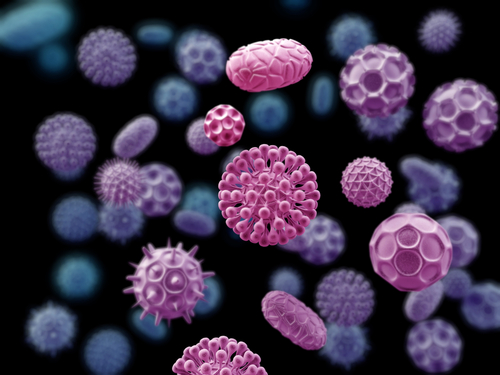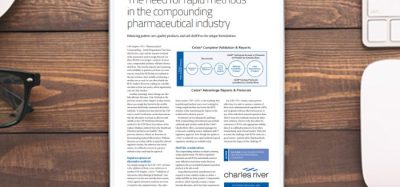Article 3: The implementation of rapid microbiological methods
Posted: 24 June 2010 |
This is the third in a series of articles on rapid microbiological methods that will appear in European Pharmaceutical Review during 2010. Rapid microbiological methods (RMMs) have been implemented by a number of companies around the world. In some cases, it is necessary to work with regulatory authorities in order to effectively introduce a RMM in place of an existing microbiology method. This is especially true if the existing method is incorporated in a previously approved regulatory dossier, such as a New Drug Application (NDA) or Marketing Authorisation.


This is the third in a series of articles on rapid microbiological methods that will appear in European Pharmaceutical Review during 2010. Rapid microbiological methods (RMMs) have been implemented by a number of companies around the world. In some cases, it is necessary to work with regulatory authorities in order to effectively introduce a RMM in place of an existing microbiology method. This is especially true if the existing method is incorporated in a previously approved regulatory dossier, such as a New Drug Application (NDA) or Marketing Authorisation.
There are different perspectives on RMM validation, submission and implementation strategies, depending on the regulatory body your products are registered with, and/or which local inspectorate is responsible for conducting GMP audits at your manufacturing facilities. Both the U.S. Food and Drug Administration (FDA) and the European Medicines Agency (EMA) have provided guidance on the intro – duction of new technologies and have presented their positions on the acceptance and implementation of RMMs. In this issue, we will explore the perspectives from the FDA (the next issue will focus on EMA perspectives).
FDA and the desired state of manufacturing
In 2002, the FDA Science Board hosted several discussions over the state of pharmaceutical manufacturing. During these meetings, it became obvious that the pharmaceutical industry faced numerous challenges regarding the understanding and control of manufacturing processes, and that there were significant opportunities for improvement. The information gathered during these meetings resulted in the development of a shared vision for the future that would benefit not only the FDA but also the industry as well. Today, this vision is more commonly known as the ‘desired state’ for pharmaceutical manufacturing in the 21st Century.
Recommendations for how the industry can achieve the ‘desired state’ were incorporated into a number of regulatory initiatives that encourage the pharmaceutical industry to implement risk-based approaches, to apply modern quality management techniques to all aspects of pharmaceutical production and quality assurance, and to adopt new scientific and technological advances to help understand, better control, and continuously improve manufacturing processes. For pharmaceutical microbiologists, the implementation of novel technology platforms, such as RMMs, allows the industry a means for meeting these expec – tations from a microbial control perspective.
Pharmaceutical CGMP’s for the 21st Century: a risk-based approach
This initiative1 is designed to use an integrated systems approach to regulating pharmaceutical product quality, and is based on science and engineering principles for assessing and mitigating risks related to poor product and process quality. We are encouraged to use the latest scientific advances in pharmaceutical manufacturing and technology (including RMMs) to achieve the FDA’s vision of the future desired state of pharmaceutical manufacturing.
Process Analytical Technology (PAT)
The PAT initiative2 describes a regulatory framework that encourages the voluntary development and implementation of innovative approaches in pharmaceutical development, manufacturing and quality assurance. PAT is a system for designing, analysing and controlling manufacturing through timely measurements of critical quality and performance attributes of raw and in-process materials and processes with the goal of ensuring final product quality and improving manufacturing efficiencies. This initiative operates under the principle that quality cannot be tested into products; rather, it should be built-in or should be by design.
Many new technologies are currently available that provide information on physical, chemical and microbiological characteristics of materials to improve process understanding and to measure, control and/or predict product quality and performance. Companies that introduce PAT into their routine operations may realise reduced production cycle times by using on-, in-, and/or at-line measurements and controls, an elimination of rejects, scrap and re-processing, the use of real-time release and an increase in automation that improves operator safety and the reduction of human errors.
Sterile drug products produced by aseptic processing – CGMP
This guidance document3 updates the 1987 FDA guidance primarily with respect to personnel qualification, cleanroom design, process design, quality control, environmental monitoring and review of production records. With regard to RMMs, the guidance recommends the use of rapid genotypic methods for microbial identification, as these methods have been shown to be more accurate and precise than biochemical and phenotypic techniques. Furthermore, the document states that other suitable micro – biological tests (e.g., rapid methods) can be considered for environmental monitoring, in-process control testing and finished product release testing after it has been demonstrated that these new methods are equivalent or better than conventional methods.
RMMs for sterility testing of cellular and gene therapy products
The FDA’s Center for Biologics Evaluation and Research (CBER) has recently provided a draft Guidance for Industry4 for the validation of growth-based rapid microbiological methods for sterility testing of cellular and gene therapy products. The guidance applies to somatic cellular therapy and gene therapy products and does not apply directly to human cells, tissues and cellular and tissue products.
Encouragement from FDA’s microbiology staff
During the 2007 PDA 2nd Annual Global Conference on Pharmaceutical Microbiology, Dr. Brenda Uratani, consumer safety officer for the Center for Drug Evaluation and Research (CDER), described the benefits of using a RMM, and these included automating the testing process, electronic capture of test data and information creation, the ability to initiate investigations earlier as compared with conventional methods, the reduction of risk associated with microbial contamination, and the use of the data as a continuum for process improvement.
In 2006, Drs. David Hussong and Robert Mello (New Drug Microbiology Staff at CDER) published a paper on the use of alternative microbiology methods and pharmaceutical quality control5. They stated the following: “New microbiology methods can offer advantages of speed and precision for solving microbiological problems associated with materials or environmental influences. Neither Corporate economics nor regulatory attitudes should be a barrier to the use of new testing technologies or different measurement parameters. In fact, if we are to increase our understanding of quality-based products and processes, then quality by design principles and risk analysis methods must be extended to the development of new microbiological technologies. This approach will drive process engineering to yield real, measurable gains in microbiological product quality assurance.”
Dr. Bryan Riley, New Drug Microbiology Staff at CDER, published a 2004 paper describing the opportunities for RMMs within the pharmaceu – tical industry6. Dr. Riley writes, “The use of rapid microbiology methods by the pharmaceutical industry should offer many advantages. Receiving microbiology test results sooner will provide for better control and understanding of the manufacturing process via faster feedback. Appropriate validation of rapid microbiology methods is necessary to ensure that the test is suitable for its intended purpose. However, it should be noted that the existing traditional microbiological test methods leave a lot of room for improvement. Therefore, it is not necessary to demonstrate that a new rapid method is flawless, only that it is not inferior to the current method, and will thereby provide equivalent assurance of microbial quality. Current FDA initiatives should help assure industry of the agency’s understanding of the potential importance of rapid microbiology methods. These initiatives should also convince industry that FDA will assess rapid methods scientifically and not place undue regulatory burdens on firms interested in using these methods. There are many exciting potential uses for rapid microbiology methods in the pharmaceutical manufacturing process, and industry should not feel that FDA will be a hindrance to the appropriate use of these methods.”
Strategies for implementing RMMs
The appropriate pathway for rapid microbiology submissions to FDA is best determined through direct dialogue with the agency. The PAT initiative recommends discussion with FDA regarding all aspects of implementation for new process analytical methods, and until RMMs become more widespread in the pharmaceu – tical industry, Dr. Riley suggests that it may be simplest to implement new rapid methods on a post-approval basis, unless the RMM change will only impact in-process microbiology methods that are not included in formal product registrations. In this case, the change may be managed through a firm’s internal change control program instead of a formal regulatory process.
Within the United States, PDA Technical Report #337 and USP Chapter 8 can serve as a jumping off point for discussions with the FDA on the validation and implementation of a RMM. There are a number of options for qualifying a RMM that will be used to support the manufacture of FDA-regulated drug product. If the RMM will be used with a new product, a firm may include the RMM in a new drug application. If the RMM will be used with an existing product, and the RMM will replace a microbiology method that has been included in the product’s original regulatory submission, then it may be necessary to file a post-approval change or prior-approval supplement in the relevant Chemistry, Manufacturing and Controls (CMC) sections for that product. Once a RMM has been approved, either in an NDA, ANDA or a prior-approval supplement, subsequent product filings may include the RMM in an Annual Product Report. Another option is to file a comparability protocol and manage the method change through the FDA PAT initiative. A number of companies have already used these strategies for RMM approvals in the U.S.
Summary
This article provides a brief overview of FDA regulatory perspectives when validating and implementing RMMs. Because RMM qualifi – cation strategies can be influenced by the RMM technology, method or application, and/or the product or test sample, it is important to discuss your proposed plans with the FDA in advance of finalising your testing approach. This is especially true when a formal regulatory change may not be necessary.
For a more in-depth review of regulatory perspectives and RMM implementation, visit http://rapidmicromethods.com, a new website dedicated to the advancement and implementation of rapid microbiological methods that is due to launch in May 2010.
References
1. FDA Final report for pharmaceutical cGMPs for the 21st Century – A risk-based approach. U.S. Department of Health and Human Services, Food and Drug Administration, Rockville, Maryland (2004).
2. FDA Guidance for industry: PAT – A framework for innovative pharmaceutical development, manufacturing, and quality assurance. U.S. Department of Health and Human Services, Food and Drug Administration, Rockville, Maryland (2004).
3. FDA Guidance for industry: Sterile drug products produced by aseptic processing – Current good manufacturing practice. U.S. Department of Health and Human Services, Food and Drug Administration, Rockville, Maryland (2004).
4. FDA Draft Guidance for Industry: Validation of Growth-Based Rapid Microbiological Methods for Sterility Testing of Cellular and Gene Therapy Products. U.S. Department of Health and Human Services, Food and Drug Administration, Rockville, Maryland (2008).
5. Hussong, D.; Mello, R. Alternative Micro biology Methods and Pharmaceutical Quality Control. American Pharmaceutical Review. 9(1): 62-69 (2006).
6. Riley, B.S. Rapid Microbiology Methods in the Pharmaceutical Industry. American Pharmaceutical Review. 7(2): 28-31 (2004).
7. PDA Journal of Pharmaceutical Science and Technology. Evaluation, Validation and Implementation of New Microbiological Testing Methods. Supplement 54(3). Parenteral Drug Association, Bethesda, Maryland: 2000.
8. General Information Chapter , Validation of alternative microbiological methods. USP 32-NF27, U.S. Pharmacopeial Convention, Rockville, Maryland: 2009.
About the Author
Dr. Michael J. Miller
Dr. Michael J. Miller is an internationally recognised microbiologist and subject matter expert in pharmaceutical microbiology and the design, validation and implementation of rapid microbiological methods. He is currently the President of Microbiology Consultants, LLC (http://microbiologyconsultants.com). In this role, he is responsible for providing scientific, quality, regulatory and business solutions for the pharmaceutical industry and suppliers of new microbiology technologies. Over the past 21 years, Dr. Miller has held numerous R&D, manufacturing, quality, consulting and business development leadership roles at Johnson & Johnson, Eli Lilly and Company, Bausch & Lomb and Pharmaceutical Systems, Inc. Dr. Miller has authored over 100 technical publications and presentations in the areas of rapid microbiological methods, PAT, ophthalmics, disinfection and sterilisation, and is the editor of PDA’s Encyclopaedia of Rapid Microbiological Methods. He currently serves on a number of PDA’s program and publication committees and advisory boards, and is co-chairing the revision of PDA Technical Report #33: Evaluation, Validation and Implementation of New Microbiological Testing Methods. Dr. Miller holds a Ph.D. in Microbiology and Biochemistry from Georgia State University (GSU), a B.A. in Anthropology and Sociology from Hobart College, and is currently an adjunct professor at GSU. He was appointed the John Henry Hobart Fellow in Residence for Ethics and Social Justice, awarded PDA’s Distinguished Service Award and was named Microbiologist of the Year by the Institute of Validation Technology (IVT).
Issue
Related topics
New Drug Application (NDA), Process Analytical Technologies (PAT), Rapid Microbiological Methods (RMMs)








